In this article:
The pegan diet is an eclectic eating plan that includes the healthiest elements of both the paleo diet and veganism. With the world becoming increasingly health conscious, people are willing to try out all sorts of different diets.
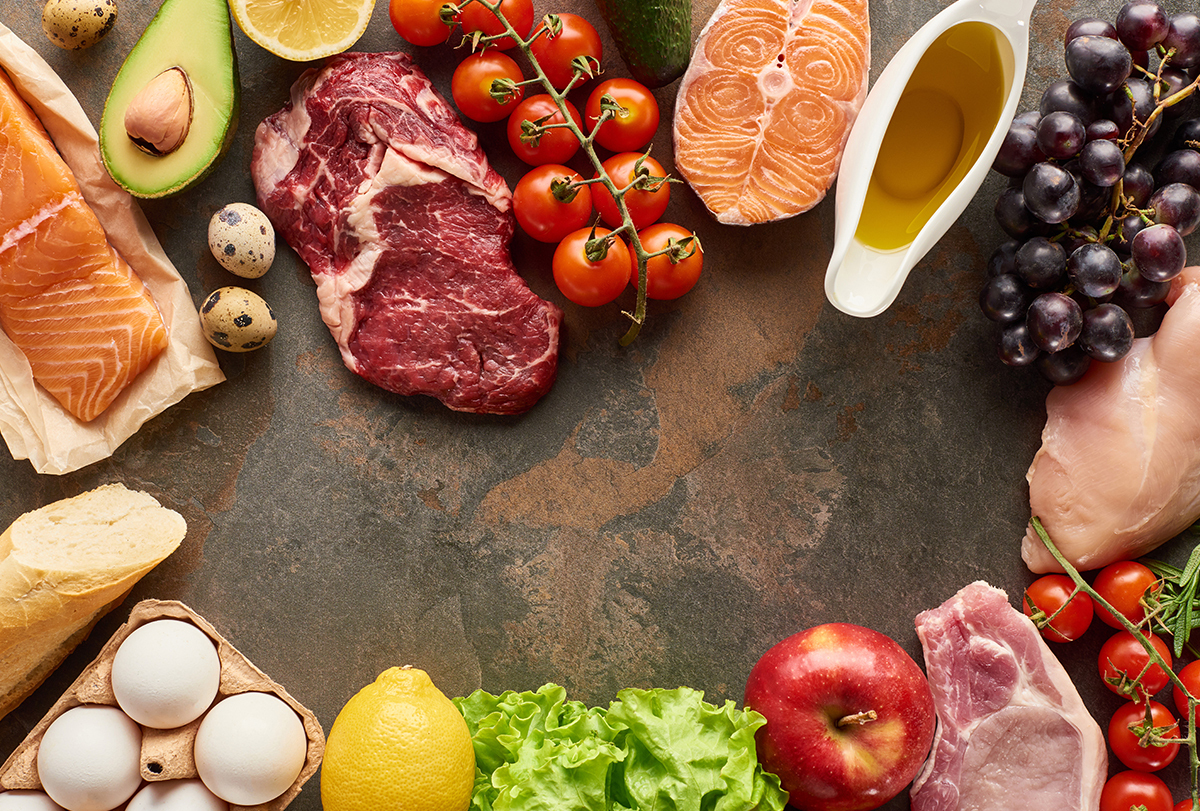
Healthy and clean eating is considered no less than an art form, and paleo and vegan diets have emerged as the mainstream favorites.
There is no one best way when it comes to eating for health. You must take into account your individual fitness goals, nutritional needs, and health concerns before zeroing in on a diet plan.
What Is the Pegan Diet?
The nomenclature of the pegan diet is indicative of its roots and can be traced back to two parent diets: paleo and veganism. (1)
The paleo diet principally includes foods that can be dated back to the Paleolithic era, some 2.6 million years ago, before the advent of agriculture. Those who follow this diet are allowed to eat vegetables, nuts, fruits, fish, and meat, while swearing off dairy, grains, oils, salt, caffeine, alcohol, and legumes.
A vegan diet, (2) on the other hand, lays emphasis on plant-based eating. It includes vegetables, grains, nuts and fruits, and other foods made from plants. Because vegans cannot consume any form of animal-based products, including dairy and poultry, choices for eating out are quite limited.
The paleo diet may offer a little more flexibility with regard to what you can and cannot eat. However, as the food choices are not clearly demarcated, it can get quite confusing to determine what counts as paleo and what does not.
The pegan diet is a more convenient alternative to these standard approaches, one that is more moderate and healthier than either plan individually. The cornerstone of this eating plan is to limit the consumption of empty carbs or high-glycemic-index foods, which often cause your blood sugar to rise and make appetite control increasingly difficult.
No wonder there are so many takers for the pegan diet as it helps to ensure complete nutrition along with healthy weight management.
How Does the Pegan Differ From the Vegan and Paleo Diets?
A cursory understanding of the vegan and paleo diets will have you believe that the two are antithetical. The former advocates for the removal of dairy, meat, and fish from your diet, whereas the latter encourages eating meat and fish.
Despite these obvious differences, both these dietary interventions essentially share the same premise, that is, to encourage the consumption of whole foods and plants.
Dr. Hyman designed the pegan diet with a similar objective in mind. (3) This unique diet proposes the consumption of fresh, organic whole foods to increase your vegetable intake. Additionally, the pegan diet lays emphasis on high-quality organic produce to promote clean eating.
What to Eat on a Pegan Diet
Here’s what makes the list of a pegan diet: (4)
1. Consume fruits and vegetables
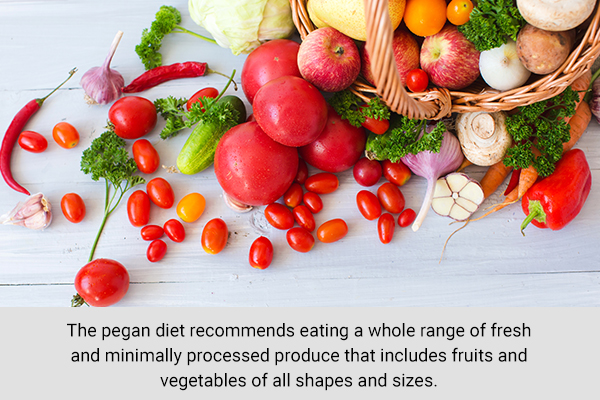
A standard meal should comprise mostly of fruits and vegetables with a side helping of meat. A plant-based main course should account for two-thirds to three-fourths of your plate, while meat should be served as a side dish.
The pegan diet recommends eating a whole range of fresh and minimally processed produce that includes fruits and vegetables of all shapes and sizes. It is best to focus on nonstarchy veggies, adding starchy vegetables and fruits to fill in the gaps.
2. Eat foods containing healthy fats
The pegan diet places a great deal of importance on foods that are enriched with healthy fats, such as omega-3 fatty acids found in fish. It also emphasizes the use of the healthy fats found in nuts, seeds, olive oil, and avocados.
Unlike veganism, this diet also makes room for animal-based products that contain saturated fats, such as butter or ghee that has been derived from grass-fed or sustainably raised cattle.
This diet also allows for the use of organic virgin coconut oil or coconut butter, both high in saturated fats.
3. Keep the glycemic load low

The paleo diet (5) does not allow the consumption of grains, whether whole or refined. However, this stipulation can deprive you of many of the long-term health benefits that are associated with whole grains.
The pegan diet, however, is not so strict in this regard. Although most grains are outlawed by the pegan school of thought, it does make a concession for gluten-free whole grains that are high in complex carbohydrates and do not drastically affect your blood sugar.
Pegan dieters can consume about a half cup of quinoa, oats, and black or wild rice per day, which is a serving about the size of a lightbulb.
4. Use meat as a condiment
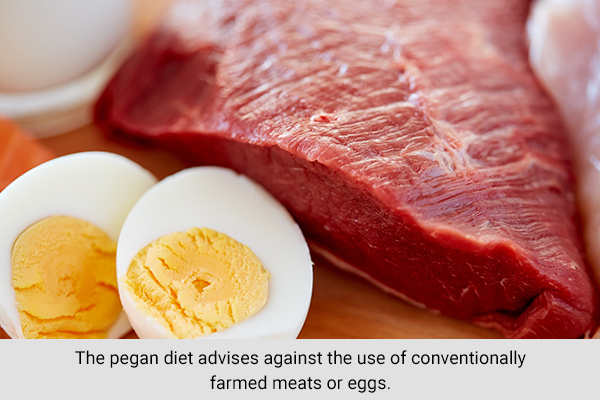
There is a lot to be said about the health merits of nonindustrial meat sources. This type of meat contains a plethora of beneficial vitamins and minerals, in addition to a high dose of protein. However, one cannot discount the fact that most meats contain saturated fat.
According to the nutritional philosophy behind the pegan diet, vegetables and fruits should be given center stage, while meat should be treated as a side dish. Your meat servings should be no more than 4 to 6 ounces per meal.
Moreover, it may help to use meat as a condiment rather than a separate dish altogether. When adding meat to your dishes, make sure that it remains a quarter or less of the total recipe.
The pegan diet advises against the use of conventionally farmed meats or eggs. Instead, it places emphasis on sustainably raised, grass-fed sources of meat and gives precedence to lean poultry or harvested low-mercury fish.
What Not to Eat
Try avoiding these foods when on a pegan diet:
1. Gluten is off the table
Gluten-containing grains and products are strictly off the table for anyone following the pegan diet. Thus, if you want to do it right, you must give up on whole-wheat bread, cereal, and pasta.
Instead, you can supplement your meals with gluten-free grains such as brown rice, quinoa, and oatmeal, but make sure that your daily consumption remains limited to half a cup, tops.
2. Avoid dairy
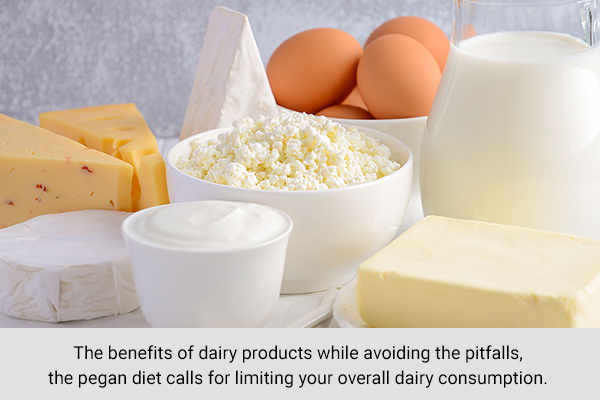
Dairy products are excluded from both paleo and vegan diets. Health experts do not acknowledge dairy as a substantial health food and suggest that you can do without it.
A lot of people misguidedly tilt towards dairy products to fulfill their calcium needs. However, there are plenty of nondairy calcium-rich foods such as collard greens, broccoli, sardines, and salmon.
Keeping in mind that dairy products are not well tolerated by many, getting your calcium from other sources may be your best option. Additionally, consuming large volumes of whole-fat dairy may contribute to the development of obesity, diabetes, heart disease, and cancer.
In order to reap the benefits of dairy products while avoiding the pitfalls, the pegan diet calls for limiting your overall dairy consumption.
If you are a fan of dairy, you can enjoy your occasional yogurt, kefir, grass-fed butter, ghee, and even cheese. It may also help to stick with goat or sheep products, which are lower in lactose than the high-lactose-containing cow dairy.
3. Stay away from GMO foods and foods exposed to pesticides, antibiotics, and hormones
The pegan diet emphasizes the need for clean eating, which entails eating organically grown, quality foods that are devoid of chemicals, additives, preservatives, dyes, artificial sweeteners, or other junk ingredients.
4. Eat legumes sparingly
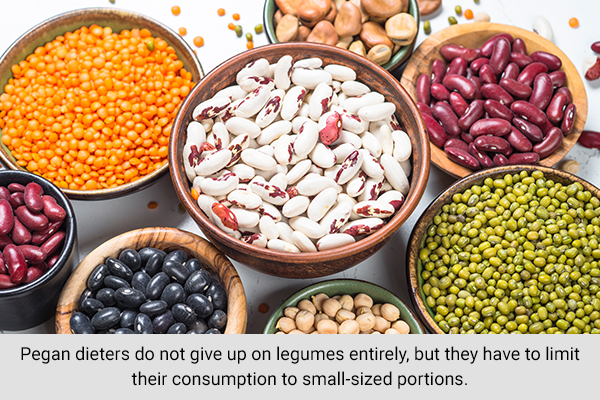
Pegan dieters do not give up on legumes entirely, but they have to limit their consumption to small-sized portions. Lentils are generally preferred over beans as the former are easier to digest.
Additionally, the larger-sized starchy beans have been shown to increase blood sugar in diabetics or prediabetics. However, one cannot look past the fact that beans are a good source of fiber, protein, and minerals.
All things considered, the consumption of legumes and beans should be kept to 1 cup or less per day, as stipulated by the pegan diet.
5. Treat yourself to sugar only once in a while
Minimize your sugar intake if you wish to maximize the health benefits of the pegan diet. You can consume something that contains sugar occasionally, but do not make a habit out of it.
6. Eliminate processed modern food-like substances and fats
The pegan diet does not permit the consumption of processed carbohydrates, as they are high on the glycemic index and consuming them can lead to excessive insulin production.
Similarly, the diet prohibits the use of refined vegetable and seed oils such as canola and sunflower oils, which are regarded as pro-inflammatory and can account for a large chunk of your regular calorie intake.
Instead, peganism recommends the use of small amounts of expeller or cold-pressed nut and seed oils such as macadamia, sesame, and walnut oils as condiments or flavoring. For cooking at a higher-temperature, avocado oil is a good choice.
Benefits of the Pegan Diet
Here are the benefits offered by the pegan diet.
1. Helps you avoid health risks
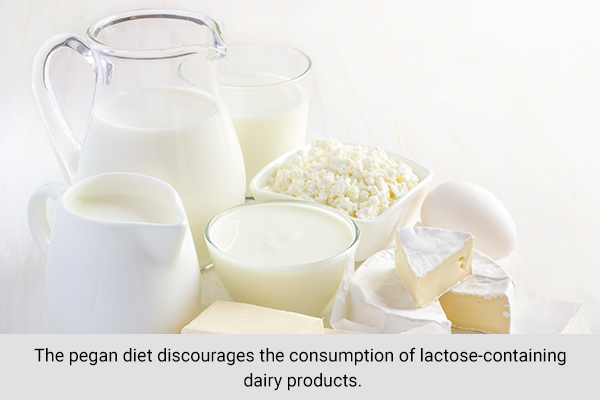
The pegan diet discourages the consumption of lactose-containing dairy products, which some people find hard to let go. However, if you look at the bigger picture, you will see how this particular dietary restriction works in the interest of your overall health.
People who consume a lot of dairy products are at a greater risk of prostate cancer, ovarian cancer, and type 1 diabetes, which should convince you to ease up on dairy and make the transition to the pegan diet a lot easier.
2. Encourages clean eating
Most fad diets that have come and gone over the years are formulated with a myopic view of what nutrition really is. They are mostly concerned with managing your calorie intake or the macronutrient ratios (carbs vs. fat vs. protein) without paying any attention to food quality.
The pegan diet is not a single-minded approach; it gives as much weight to clean eating as it does to healthy eating, making it a cut above the rest.
It pushes for the consumption of organic, quality foods that are devoid of harmful pesticides, antibiotics, and other dangerous chemicals. As a result, you end up with nutritionally “denser” meals.
3. Helps you lose weight
Given that fruits and vegetables are the mainstays of a pegan diet, it is more than equipped to supply you with various health-promoting vitamins, minerals, and other nutrients.
Besides, fruits and vegetables are rich in fiber, which makes them extremely effective in weight loss, weight management, and keeping oxidative stress at bay.
The fiber keeps you feeling full for longer, without adding to your calorie load. As a result, your overall appetite is kept in check, and you can easily avoid unnecessary snacking between meals.
4. Good for your heart

Unsaturated fats are an essential component of a healthy, wholesome diet, which plays a vital role in improving your heart health. The pegan diet allows for the consumption of healthy unsaturated fats.
Doing so helps manage your cholesterol levels and blood pressure, thereby promoting overall cardiovascular functioning.
Popular Pegan Diet Recipes
Here are two easy and delicious pegan recipes you can try.
1. Pegan hummus veggie wrap
Ingredients:
- 2 large flour or brown rice tortillas or whole-wheat wraps
- 4 leaves of romaine lettuce with the ribs removed
- ¼ red bell pepper that has been sliced into thin strips
- 6 tablespoons of oil-free hummus
- 4 tablespoons of cucumber, cut into julienne strips
- Tomato (optional)
- Basil leaves (optional)
- Avocado (optional)
- Alfalfa or broccoli sprouts (optional)
- Spinach leaves (optional)
- Fresh microgreens (optional)
Directions:
There is no one way to cook tortillas, so you can use whichever mode suits you best. You can cook either side of the tortillas in a skillet over medium heat for 30 seconds.
Alternatively, you can char them directly over the gas flame for a few seconds using tongs. Tortillas can even be warmed in the microwave. Simply cover them with a moist paper towel, and put them in the microwave for 10 seconds to make them more flexible.
- Apply a smearing of about 3 tablespoons hummus over each tortilla.
- Add half of the vegetables of your choice, including the optional ingredients, to each tortilla, with lettuce coming last.
- Roll the tortilla into a wrap and cut each in half or eat it whole.
2. Grilled chicken breasts with shiitake mushroom vinaigrette
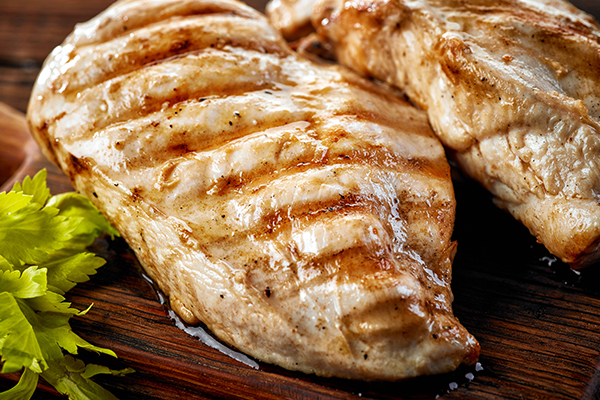
Ingredients:
- 5 large shiitake mushrooms with the stems removed
- 6 tablespoons of canola oil
- 1 teaspoon of whole-grain mustard
- 3 tablespoons of balsamic vinegar
- 3 tablespoons of extra-virgin olive oil
- Salt to taste
- Freshly ground black pepper
- 4 bone-in, skin-on chicken breasts (about 8 ounces each)
- 4 tablespoons of finely chopped flat-leaf parsley, plus torn leaves for garnish
Directions:
- Heat the grill to a high temperature.
- Brush 4 tablespoons of the canola oil on either side of the mushroom caps and season them with salt and pepper.
- Place the mushrooms on the grill with the cap side down for 4 to 5 minutes, until it turns golden brown and slightly charred.
- Flip the mushrooms over and continue cooking for 3 to 4 minutes longer, until they are just cooked through.
- Take them off the grill and chop them coarsely.
- For the vinaigrette, whisk together the shallots, extra virgin olive oil, vinegar, and parsley in a medium bowl and season the mix with salt and pepper.
- Dump the mushrooms in the mix. Stir them so they get nicely coated.
- Let this shiitake mushroom vinaigrette rest at room temperature for at least 15 minutes before serving.
- Coat both sides of the chicken breast with the canola oil that is left and season it with salt and pepper.
- Place it on the grill with the skin-side facing down for 4 to 5 minutes until it turns golden brown.
- Turn it over and simmer down the heat of the grill to medium.
- Cover the grill and let the chicken cook for about 7 minutes longer, until it becomes almost done.
- Remove the chicken from the grill and let it sit for 5 minutes before serving.
- Add the shiitake vinaigrette as dressing on top of the chicken breast and garnish with parsley leaves.
The Downside of Eating Pegan
Although there is much more wiggle room in the pegan diet in comparison with the vegan or paleo diet, some of the dietary restrictions proposed are still subject to debate since it limits or eliminates some very healthy foods, such as legumes, whole grains, and dairy.
- The pegan philosophy discredits the health potential of whole grains, legumes, and dairy products on the grounds that foods with gluten or lactose are harmful. The counter-argument is that all of these foods are a rich source of protein, fiber, antioxidants, and a wide array of other nutrients. Thus, there is no point in depriving yourself of their healthy goodness, unless you have a medical reason to avoid gluten or lactose.
- Milk is one of the primary sources of bone-strengthening minerals for women. By excluding milk, yogurt, and kefir from its food choices, the pegan diet can drastically reduce their supply of calcium and set the ground for joint problems including osteoporosis. By shunning dairy products completely, you will also be eliminating an important source of protein and probiotics.
- One cannot simply eliminate the consumption of whole wheat foods and also limit whole foods such as quinoa, brown rice, oats, or beans, as they provide components for important functions and are excellent sources of various nutrients. Whole foods provide fiber that helps control blood sugar levels, regulate intestinal flora, and regulate digestion. They also keep you satiated for much longer, providing bulk and thereby helping in weight loss.
- The pegan diet is not a sustainable eating plan for athletes and others with higher energy, carbohydrate, and protein needs. As an athlete, you cannot expect to meet all of your protein needs from plant-based sources. This is also exacerbated by the cap on the consumption of whole grains and beans.
Final Word
What works for one may not work for another. Everyone is unique with varying nutritional needs. This uniqueness is referred to as bio-individuality and is the reason why everyone should enlist the help of a trained nutritionist to personalize their diet to meet their needs.
Dr. Mark Hyman is the founder of a new age diet that has gained a lot of traction in recent times – the pegan diet. This diet incorporates elements from the paleo diet and veganism, creating a healthy hybrid eating plan that guarantees wholesome nutrition and improved body function.
The pegan diet offers the right balance of essential nutrients, healthy fats, and other vital compounds that keep your body at the peak of health.
- Was this article helpful?
- YES, THANKS!NOT REALLY


